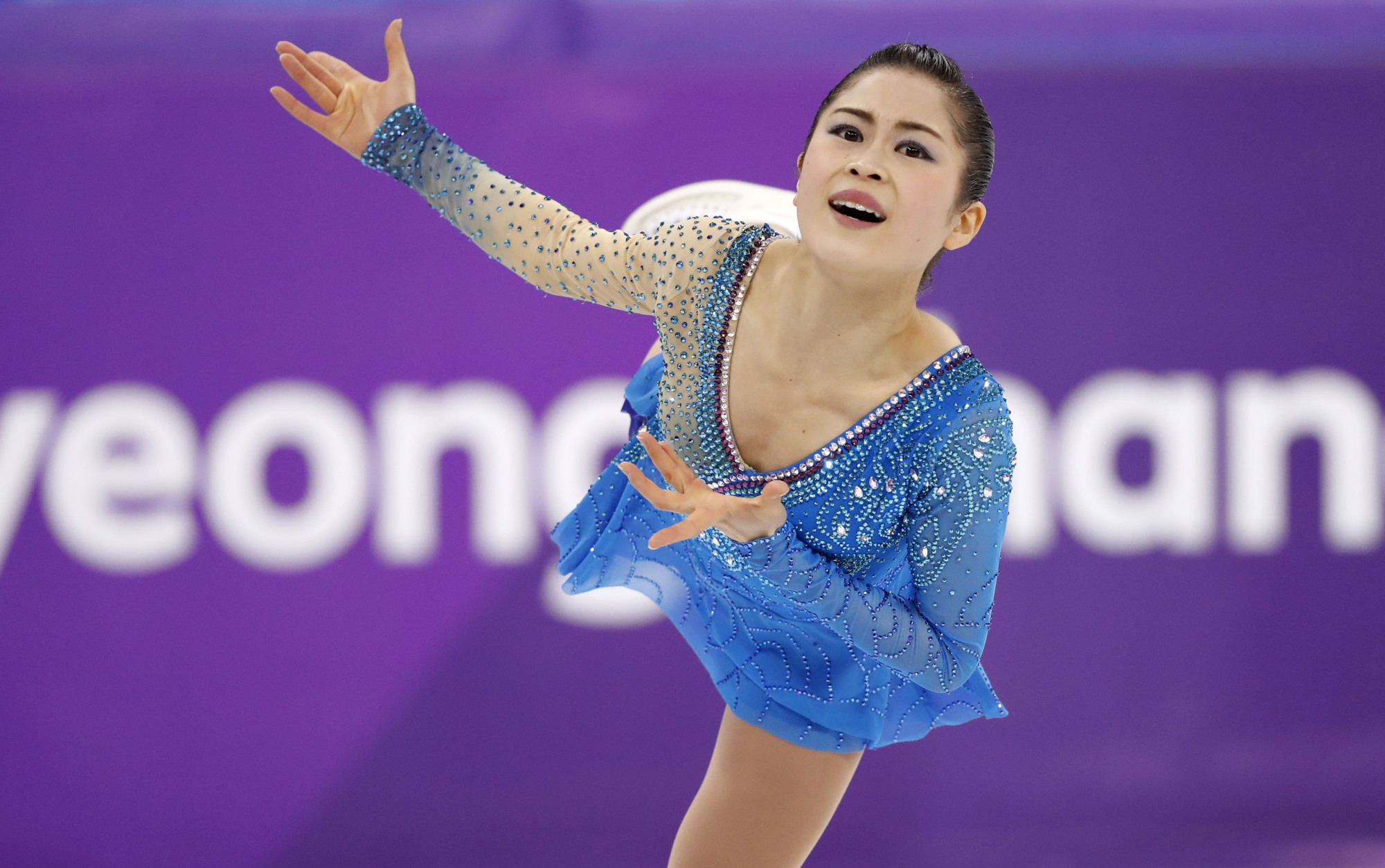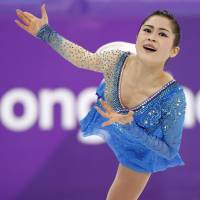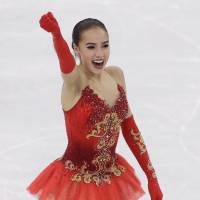In the wake of Alina Zagitova and Evgenia Medvedeva winning the gold and silver medals in such dominating fashion at the Pyeongchang Games, many are wondering how the Japanese women can close the gap on the powerful Russians going forward.
Zagitova, with a score of 239.57 points, finished more than 17 points ahead of Satoko Miyahara (222.38), who was fourth, in the final results, while Medvedeva (238.26) was nearly 16 points in front of Japan's four-time national champion.
Kaori Sakamoto (209.71) was farther back in sixth place.
Ice Time spoke to two-time Olympic bronze medalist Philippe Candeloro of France, who worked for French TV at the Olympics, two journalists and a coach to get their views on this issue.
"I think the Japanese did fine here, they had two women in the first six places," Candeloro stated.
"What can I say about this? It's like the artistic impression from Russia with the Bolshoi Ballet and everything," Candeloro continued. "They will forever have better marks for artistry."
Candeloro, who claimed the bronze at both the 1994 Lillehammer Olympics and 1998 Nagano Games, thinks the body types of skaters from the two countries is a factor.
"It's a question of attitude, of physicality," Candeloro commented. "The judges will prefer the Russian style more than the Japanese style, even if the Japanese make quads.
"We also have Russians (women) doing quads soon. What is it going to be in the next five or 10 years?"
Candeloro feels it is time for some changes.
"So I think the rules of skating competition will change soon," Candeloro said. "We should have a technical competition and an artistic competition on style.
"Because for European skating, it is so low except for the Russians, and they are good now only for the girls and pairs," Candeloro added. "They start to lose first place in the rankings.
"It is going to be difficult for a European skater to say, 'OK. I have a chance. I can compete for worlds because I have a chance,' " Candeloro added. "It is going to be difficult for them. We need to find a different form of competition, to make everybody happy and have a chance to win something."
Ice Time questioned Candeloro about Eteri Tutberidze, the star Russian coach of both Zagitova and Medvedeva.
"She is a good manager," Candeloro stated. "She has control of all the people on her staff and they do good work. The students are like soldiers. The students listen and the students work."
Candeloro believes motivation is also driving the Russian revolution.
"In America, they have the good spirit and they always enjoy what they are doing," Candeloro noted. "This is the same for the Canadians, they enjoy what they do. In North America, they always enjoy what they do, which is a good, positive attitude.
"As for other European countries, we think they don't want to work enough," Candeloro said. "They need to get hurt. To win, you need to get hurt. In Europe, life is so good, maybe they are not motivated enough to fight."
Ice Time reached out to a prominent Japanese skating writer, who asked that their name not be used, about how the gap with Russia can be closed by Japan's female skaters.
"The rules may be changed next year to eliminate the bonus in the second half," the writer stated. "Other changes the Japanese want include increasing the base value of the triple axel, because many girls coming up in Japan now are trying it.
"The triple axel value is just 8.5 points, which is very low," the writer added. "With many Japanese girls doing it, a change would help in the next four years. This would give them a better chance."
I wondered if the writer thought Kaori Sakamoto would be on Japan's team for the 2022 Beijing Games.
"Kaori is a jumper. Four years from now she will have to show more emotion and artistry in her programs," the writer assessed. "But she might continue to just focus on jumping.
"Satoko is a more well-rounded skater, so she will have a chance again to make the team in four years. She is a very hard worker."
A well-known European skating journalist, who requested anonymity, told me she didn't see the difference between the Japanese and Russians as being that significant.
"I think the Japanese ladies skaters are in a good way," the journalist commented. "Because they had a very good result here and they are technically good."
The journalist cited the Russians adeptness at skating clean programs as being what puts them ahead at this point.
"What they still can improve, like Alina has a technical advantage with her triple lutz/triple loop, like doing very difficult stuff," the journalist said.
"Being absolutely consistent. I think that is really the key that has put the Russians in this position. They are really, really consistent, the ladies. You hardly see them miss anything in competition or practice. That is probably the next step for Japan."
The journalist singled out Miyahara for her fine programs.
"The Japanese programs are also good," the journalist stated. "Especially Satoko has good programs. Satoko has a little bit of a disadvantage in that her jumps are not as high and there are under-rotation problems. You need to be absolutely clean as a whistle with the elements, and consistent."
The European journalist does not believe the triple axel is that big of a factor in the bigger picture.
"The triple axel alone isn't making the big difference," she said. "As you could see with Mirai Nagasu, she landed the triple axel, but it's not all about one element.
"I don't think the value will be increased. Now they don't want the men doing so many quads that they can't do really. Only encourage people to do stuff they can really do."
Where does the increasing talk about turning the short program and free skate into athletic and artistic programs stand? Ice Time inquired.
"That's far in the future. That won't happen until after Beijing," the journalist felt. "The process of thinking about that has just started."
She then described what some in the skating community are envisioning going forward.
"There would be two programs. A technical one and an artistic one with limited jump content," was the journalist's analysis. "To have three separate medals including combined total.
"In figure skating, now there is the team event. But compared to other sports, there are still far fewer chances to get medals in skating than in skiing or speedskating events."
The coach, who also did not want to be named, also highlighted the ability of the Russians to be nearly perfect time after time on the ice.
"The Russian women generally do not make a mistake," the coach stated. "Satoko did not make a mistake. She was pretty good and clean on her jumps. She has a problem with that sometimes. She is not a big jumper.
"The Japanese women are equal in so many parts, but they might make one more mistake, which is the difference," the coach commented. "The Russian women simply do not make mistakes and also they jump a little bit bigger, so they have a little room for error when something goes a little bit wrong in the air, so they have a bit more time to save it."
There has been a lot of talk in skating circles about how the Russian skaters — especially Zagitova — put nearly all of their jumps in the second half of their programs.
"They backload their programs, which gives them extra points," the coach noted. "People complain about that, saying, 'Well, it's an unbalanced program.'
"What are you talking about? This is sport. Can you tell a guy who is running a marathon that you are not allowed to hang back and you have to sprint from the start? The race is run through time."
The coach felt it is the same scenario with skating.
"The program is strategic through time," the coach commented. "If you can backload your program and do all those jumps when you are more tired, and still have a pleasing program overall, then so be it.
"The Russians have been able to do that. So they are getting those extra points, because most of their jumps are in the second half of the program. That is another advantage they have."
In the coach's opinion, Russia and Japan are above just about everybody else in skating.
"I don't see the Russians and Japanese very far apart. I see the rest of the world quite far apart from those two. There are some skaters, like (Canada's) Kaetlyn Osmond, who are good," the coach said. "But the Russians and Japanese, they are strong. They are consistent. What I see is the Japanese making a little untimely mistake.
"Satoko's performance skills are of the highest level," the coach added. "You are talking about such small differences."
While some may be concerned about Japan's female skaters catching up to the Russians, the coach isn't one of them.
"The Japanese are not quite as powerful as the Russians, as commanding on the ice," the coach stated. "But the Japanese are such beautiful skaters.
"I believe the Japanese women have the best yet to come. In the next four years, they will emerge stronger than they have been in the last two years or so."





















With your current subscription plan you can comment on stories. However, before writing your first comment, please create a display name in the Profile section of your subscriber account page.